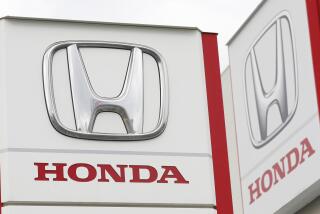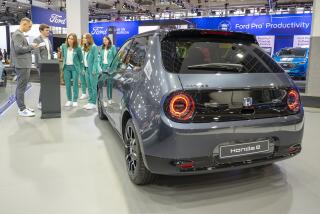Honda Safety Initiative at the Finish Line
John Mendel was chief operating officer at Mazda North America three years ago when he heard that American Honda was promising an industry-leading package of safety equipment on its mainstream models by 2006.
Mendel vividly recalls going to his boss at the time and saying, “The oven just got hotter.”
Now it is Mendel stoking the safety fires as senior vice president of Honda Motor Co.’s Torrance-based U.S. automotive operations.
With the introduction this month of the 2007 Honda Element, the Japanese automaker has kept its 2003 promise.
But more than that, the No. 2 foreign brand in the U.S. wants to surpass leaders Volvo and Mercedes-Benz in the automotive safety field and keep finding ways to distinguish itself from larger rival Toyota Motor Corp.
Mendel, who joined Honda in November 2004, said the company intended to continue adding increasingly sophisticated safety systems to its vehicles -- making them standard when economically feasible -- as technology developments permit.
Although Honda’s advances are notable in and of themselves, safety specialists laud the automaker for compelling rivals to expand their offerings to remain competitive.
“This pulls the whole industry ahead,” said Adrian Lund, president of the Insurance Institute for Highway Safety.
“If you are a competitor selling a Camry and Honda makes side-curtain air bags with head protection standard on its Accord, then you’ve got to follow to stay competitive,” he said, referring to Toyota and its top-selling sedan.
By completing its so-called Safety for Everyone initiative, Honda provides anti-lock braking systems and dual front air bags and side-curtain air bags as standard equipment on almost all the cars and trucks it sells in the United States.
To that basic package, Honda’s sport utility vehicles and its Ridgeline pickup add vehicle stability -- or anti-skid -- systems and rollover sensors. The sensors measure tilt and deploy the side-curtain air bags when a rollover is imminent.
Honda also will provide a vehicle stability system as a standard feature on its V-6 Accord models for the 2007 model year.
Six of Honda’s 14 models include its collision compatibility body system, and the company intends to have all its vehicles using it within five years, Mendel said.
The system, called ACE, for advanced compatibility engineering body structure, employs high-strength metals, crumple zones and specially engineered metal body pieces to enable a small vehicle to better absorb impact and protect occupants in a collision with a larger vehicle.
“Honda and Volkswagen are probably the industry leaders in terms of both safety features and performance in independent crash tests” such as those done by the insurance institute and the federal National Highway Traffic Safety Administration, said Gabriel Shenhar, senior automotive test engineer for Consumer Reports magazine.
Honda, though, is the only mainstream automaker with such a broad array of standard safety equipment; VW has a more limited lineup of vehicles.
With only its low-volume S2000 roadster and two-seat Insight gasoline-electric hybrid omitted from the Safety for Everyone program, Honda offers its package as standard equipment on 99% of the 1.5 million passenger vehicles it sells each year in the U.S. across its Honda and Acura brands, Mendel said.
Lund, whose Virginia-based institute is considered a leader in the development of automotive crash testing, said Honda vehicles not only come with an impressive array of standard safety systems but also test well.
“They have a number of vehicles that get our ‘good’ rating in side-impact crashes, and there aren’t many that do,” he said, referring to automakers in general.
“Good” is the institute’s top rating.
Honda’s promise, Mendel said, “is that you don’t have to give up performance or fuel economy to get driving safety.”
He declined to say what Honda planned to do next, but he pointed to the Advanced Safety Vehicle-3 concept car, which the company displayed at this year’s North American International Auto Show in Detroit, as the direction in which it is headed.
The vehicle’s features include computer-assisted steering and braking systems that can improve control in emergency situations, an alert system that uses cameras and radar to let drivers know of approaching vehicles and obstacles in the road and inter-vehicle communication systems that enable drivers of similarly equipped cars, trucks and motorcycles to know where they are in relation to others on the road, even in darkness and around blind corners.
Like other automakers, Honda is developing cruise control that automatically maintains a safe distance between vehicles, rear crash-mitigation systems that sense when a vehicle is closing too rapidly on the one in front and apply emergency braking to minimize collision impact, and lane-change warning systems that can alert a drowsy or distracted driver whose vehicle is wandering into another lane.
Honda’s goal is to make as much advanced safety technology available as possible and to do so without turning a relatively economical car such as the $14,560 base Civic into a luxury-priced vehicle, Mendel said.
“So far, our safety goals haven’t added much to the retail price of our vehicles,” he said.
Industry analyst Eric Noble cautions, though, that many small-car shoppers remain cost-sensitive. They might shy away from Honda’s subcompact and compact cars because those models tend to be more expensive than competing models of comparable size that would not have the same level of safety equipment.
But with Honda’s higher-priced models, such as the Accord mid-size, its trucks and the Acura luxury line, shoppers are willing to pay extra for more safety and the company regains a competitive advantage, said Noble, president of CarLab, an automotive market research firm in Orange.
Mendel said the company’s safety initiative should pay off as soaring gasoline prices push many shoppers into the smaller cars that are Honda’s specialty -- and that might otherwise give some buyers pause because of their disadvantages against larger vehicles in accidents.
With millions of large pickups and SUVs still on the roads, drivers of small cars might consider an automaker’s safety reputation a key factor in their buying decisions, Mendel said.
“Safety has continued to rise as an important factor in car purchase considerations,” he said, “and what we’re doing will pay us huge dividends going forward as the market continues to shift toward smaller cars.”






